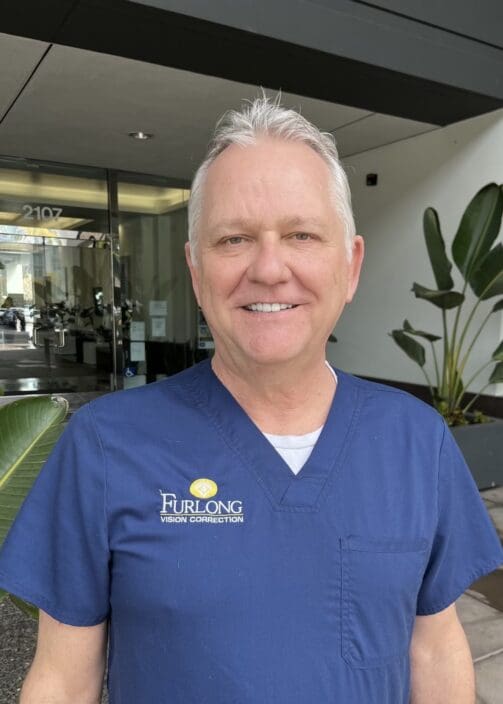
Furlong Vision Correction
LASIK in San Jose, California
Furlong Vision Correction specializes in a range of vision correction procedures, including laser vision correction, cataract surgery, RLE, ICL, and treatments for keratoconus or ectasia. Their unique offering, The Furlong Vision Promise, ensures eligible patients receive enhancements at no additional cost to maintain vision results, highlighting their commitment to patient care.
Not sure if LASIK is right for you?

99% SUCCESS RATE 99% of NVISION patients see 20/20 or better after LASIK

RAPID RECOVERY Resume your normal activities in 24 hours

COMFORT-FOCUSED LASIK is virtually painless and completed in minutes
Furlong Vision Correction
2107 N First St # 101San Jose, CA 95131
Monday: 7 AM - 5 pm
Tuesday: 7 AM - 5 pm
Wednesday: 7 AM - 5 pm
Thursday: 7 AM - 5 pm
Friday: 7 AM - 4 pm
Saturday: Closed
Sunday: Closed
Hurry, Offer Ends Soon
Book now for $1,200 off LASIK* + Enjoy Easy and Fast LASIK Financing**
Vision Correction Procedures in San Jose
Today's life-changing procedures make it possible to improve your vision to 20/20—or better.
LASIK Eye Surgery
LASIK eye surgery is a safe, highly effective solution to correct vision and eliminate the need for glasses or contacts. At NVISION, our expert surgeons use state-of-the-art technology and advanced techniques to deliver exceptional results and have you back to your routine quickly.

EVO ICL™ (Implantable Collamer Lens)
Say goodbye to glasses and contacts with EVO ICL™! This advanced procedure is an excellent option for patients who aren’t LASIK candidates. By placing a biocompatible lens in your eye—without removing the natural lens—EVO ICL™ corrects nearsightedness and astigmatism, providing clear, long-lasting vision.

Cataract Surgery
Cloudy vision holding you back? Our advanced cataract surgery, featuring laser-assisted technology and lifestyle lenses, can restore your sight and help you enjoy life’s moments clearly again.

Other Procedures
Contoura® Vision LASIK
What is Contoura® Vision LASIK?
Contoura® Vision LASIK is an advanced form of LASIK eye surgery that utilizes topography-guided technology to tailor the laser treatment to the unique characteristics of an individual’s cornea. This technology aims to provide a more personalized and precise correction of refractive errors, including nearsightedness, farsightedness, and astigmatism. Contoura® Vision creates a highly precise and accurate map of a patient’s eyes measuring up to 22,000 unique elevation points on each eye.
Key features of Contoura® Vision LASIK include:
- Topography-Guided Treatment:
Contoura® Vision LASIK utilizes detailed corneal mapping or corneal topography to create a highly customized treatment plan. This map captures thousands of data points on the cornea, allowing for a more precise analysis of its shape and irregularities. - Personalized Correction:
The topography-guided technology enables the laser to precisely reshape the cornea based on the unique imperfections detected in the corneal map. This personalized approach aims to address higher-order aberrations, improving not only traditional refractive errors but also the overall quality of vision. - Reduced Glare and Halos:
Contoura® Vision LASIK is designed to reduce the occurrence of visual disturbances such as glare and halos, which can be associated with certain refractive errors. The customized treatment may result in improved night vision and reduced sensitivity to light. - Potential for Better Visual Outcomes:
The goal of Contoura® Vision LASIK is to achieve superior visual outcomes by optimizing the correction based on the individual characteristics of the patient’s cornea.
It’s important to note that the availability of Contoura® Vision LASIK may vary, and not all LASIK centers offer this specific technology. If you are considering LASIK surgery and are interested in Contoura® Vision LASIK, it’s recommended to consult with an experienced refractive surgeon or LASIK eye doctor who can assess your candidacy and discuss the available options for personalized laser vision correction.
Refractive Lens Exchange (RLE)
Refractive lens exchange (RLE), is when a clear lens is implanted to replace your eye’s natural lens to correct your vision.
This procedure is often used for pre-cataract patients, as a preventative vision correction solution. Refractive lens exchange (RLE) can also correct nearsightedness, farsightedness, and astigmatism.
Pterygium Surgery
Pterygium surgery is performed under topical anesthesia on an outpatient basis.
PRK Surgery (Photorefractive Keratectomy)
What is PRK Surgery?
PRK Surgery (Photorefractive Keratectomy) is a type of laser eye surgery that is used to correct refractive errors such as nearsightedness (myopia), farsightedness (hyperopia), and astigmatism. PRK is an alternative to LASIK eye surgery and is particularly suitable for individuals who may not be candidates for LASIK due to certain corneal characteristics.
Overview of the PRK surgery process:
- Corneal Epithelium Removal:
- In PRK, the surgeon begins by removing the thin outer layer of the cornea called the epithelium. This can be done using an alcohol solution, a special brush, or a laser.
- Laser Reshaping of the Cornea:
- Once the epithelium is removed, a laser is used to precisely reshape the cornea. The laser ablates or removes microscopic amounts of corneal tissue based on the patient’s refractive error. The goal is to correct the curvature of the cornea and improve the focus of light on the retina.
- Healing Process:
- Unlike LASIK, where a corneal flap is created, PRK does not involve creating a flap. Instead, the corneal surface is allowed to regenerate naturally. The healing process involves the growth of new epithelial cells over the treated area.
- Post-operative Care:
- Following PRK surgery, patients are given medicated eye drops to aid in the healing process and prevent infection. Recovery may take a bit longer compared to LASIK, and patients may experience temporary discomfort during the initial days.
Key considerations for PRK surgery include:
- Corneal Thickness: PRK may be a suitable option for individuals with thinner corneas who may not be ideal candidates for LASIK.
- Occupational Considerations: PRK may be recommended for individuals with occupations or lifestyles that carry a risk of corneal injury, as it eliminates the creation of a corneal flap.
- Healing Time: The initial visual recovery may take longer with PRK compared to LASIK. Patients typically experience optimal vision several weeks after the procedure.
PRK is a well-established and effective procedure for vision correction, and its suitability depends on individual factors. It’s important to consult with an experienced refractive surgeon or eye care professional to determine the most appropriate laser eye surgery option based on your eye health and lifestyle.
Lifestyle Lenses
Lifestyle lenses are a premium lens option that offers a more functional range of vision, and are designed to reduce the need for distance and reading glasses.
We offer the latest and most advanced lifestyle lens on the market.
Intacs® Corneal Implants for Keratoconus
The surgical implantation of intracorneal ring segments or Intacs® is a minimally invasive surgical option to improve the corneal shape in patients with keratoconus.
Intacs® are surgically inserted into a thin channel created by a femtosecond laser in the periphery of the cornea. Intacs® is also known as surgical implantation of intracorneal ring segments.
Surgeons at Furlong Vision Correction

A Stanford-educated, award-winning ophthalmologist and visionary renowned for his expertise in cutting-edge LASIK and cataract procedures and his profound commitment to improving patients’ lives through exceptional care and community service.
At NVISION® Eye Centers, we provide life-changing results, an exceptional experience, and a lifetime commitment to your LASIK vision correction.
- Industry-leading surgeons and vision outcomes with more than 2 million successful procedures
- The most advanced laser and diagnostic technology available
- Financing available – no down payment, zero or low interest, low monthly payments
- Free LASIK consultations
- Use your FSA/HSA balance toward LASIK before it expires in December
Location Information
Furlong Vision Correction
2107 N First St # 101, San Jose, CA 95131
